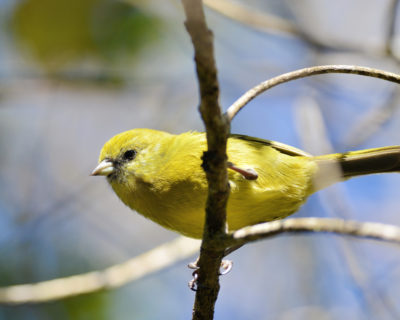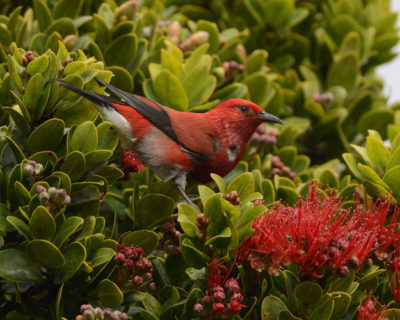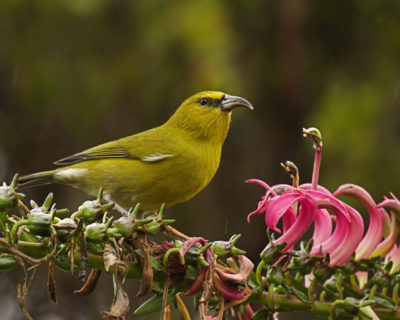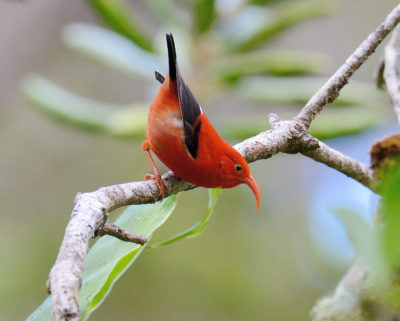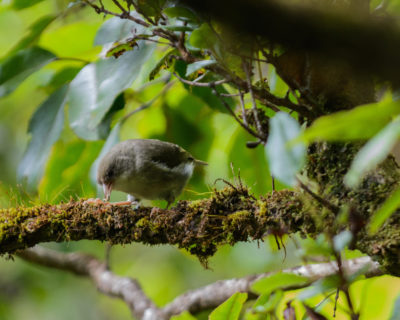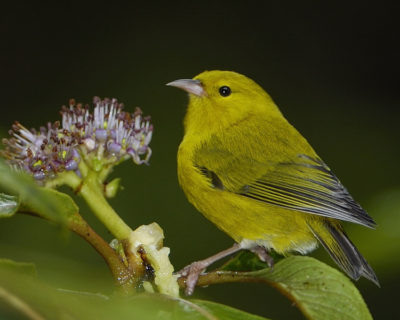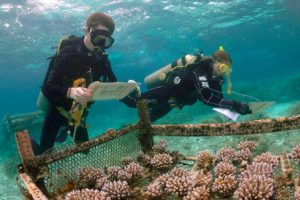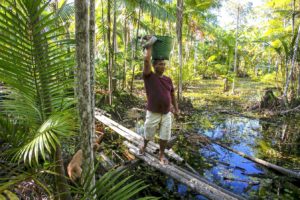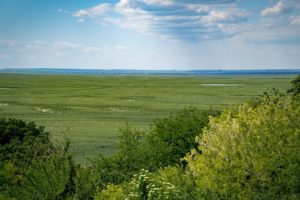The few remaining species of native forest birds left on the Hawaiian island of Kauai have suffered population declines so severe – 98 percent in one case – that some are near extinction. The cause of the collapse, according to a recent study in the journal Science Advances, is not alien plants or predators, but rather warming temperatures that have enabled non-native mosquitoes carrying deadly avian malaria to invade the birds’ high-elevation strongholds.
In an interview with Yale Environment 360, Eben Paxton, an avian ecologist with U.S. Geological Survey and lead author of the study, says his group’s research showed that the mosquitoes moved into the Alakai Plateau over the last decade, infecting the birds and pushing their populations to a tipping point. “We’re at the 11th hour,” he says.
Paxton cites a number of approaches for eradicating the mosquitoes, including releasing irradiated infertile males, altering the bacteria naturally found in these insects, and even using genetically modified mosquitoes. As he sees it, more than the birds of Kauai are at stake. “The way that we view Kauai is that it’s an early warning system for the rest of the islands,” he says. “If we get it right on Kauai then, I feel pretty good about the prospects of some of the other islands.”
Yale Environment 360: You looked at the population trends for seven species of native forest birds by comparing the results of surveys done on the Alakai Plateau. You discovered a rather dramatic population decline in all six species of Hawaiian honeycreepers. What were your findings?
Eben Paxton: What we’ve seen from going back to the 1980s is a gradual decline of forest birds. But it’s really accelerated in the last 10 to 12 years. From 2000 to 2012, we’ve seen a 64 percent decline in the core range of the birds and a 94 percent decline in much of the outer portions of their range. A number of these species now exist in very small core parts of their habitat in the interior of this mountain forest.
e360: You name avian malaria, which is transmitted by non-native mosquitoes, as the main culprit here and say the rise in its incidence is due to climate change. What’s been the warming trend at these higher elevations on Kauai?
Paxton: There’s a really strong relationship between temperature and the distribution of disease. These high elevation forests are too cool most of the time for diseases to develop. Global warming is allowing these mosquitoes to move further up in elevation.
This research builds on other research. My colleague, Carter Atkinson, posted a study last year that shows a doubling or more of disease prevalence in these forest birds in Kauai over a 15-year period. Researchers who have been working up in the Alakai Plateau for decades historically would never see mosquitoes, even though it’s a very wet, swampy place. Recently, researchers have been seeing mosquitoes up in the plateau, and we’ve been seeing this increase in disease prevalence in birds. We think that somewhere in the last decade or so, the mosquito, with the disease that it brought, started moving into the Alakai Plateau and really affecting these birds.
e360: So that’s why in your paper you describe a tipping point that’s been reached?
Paxton: Right. It’s a little different, for instance, on Maui where we have a habitat that’s still much higher than the forest on Kauai. On Maui there’s a steep elevation, so we’d expect disease to slowly creep its way up. In Kauai, because of a flat plateau, once disease gets in there it can quickly spread.
e360: It’s stunning to look at the table of population trends for these birds. Two species really seem to be teetering on the edge. You estimate in 2012, when the last field study for this research was done, there were only 468 ‘akikiki and only 945 ‘akeke’e left. Can anything be confidently said about what has happened to those birds in the intervening four years?
Paxton: There haven’t been surveys, so there is a lot of uncertainty about what the current status is. A lot of bird guides have been talking about how they just can’t find these birds anymore without going really deep into the Alakai Plateau. There are a lot of partners on this including the state and the U.S Fish and Wildlife Service. There’s a cooperative between the state and the University of Hawaii called the Kauai Forest Recovery Group. They’re working very hard on this. A lot of effort has been done to begin a captive population for ‘akikiki and akeke’e because their numbers are so low. We know they’re still extant because they [researchers] are tracking nests to collect eggs in some of the core areas.
e360: Which species suffered the greatest declines in that 2000 to 2012 period and what specifically were those declines?
Paxton: We’ve seen a 98 percent decline of the ‘akeke’e in the interior, which is pretty much where they only exist any more. In the Kauai ‘amakihi, the 91percent decline in the interior, 98 percent in the exterior, is a pretty dramatic decline for a species that was widely spread just a few decades ago.
e360: In addition to disease, these native birds have a number of pressures to contend with. Invasive plants that displace nesting and foraging plants, non-native predators like rats, and competition from non-native birds. Given that, how do you know climate change and not some of these other factors are pushing these birds towards extinction?
Paxton: We come to that conclusion for several reasons. One, we know that disease prevalence is increasing in the forest birds. We know they’re susceptible to that disease and we’re seeing mosquitoes in that habitat. The other thing is the pattern of decline. Six of the seven species declining are honeycreepers, and those are all declining very rapidly. We know that they are highly susceptible to avian malaria.
The one species that is showing declines on the periphery of their range but not their core is the Kauai ‘elepaio, which is from a different family. It’s a more recent arrival to Hawaii. We know that they are much more resistant to the disease. We also would expect habitat changes from invading plant species and non-native birds competing for the same resources would affect certain species and not others. Some species nest on locations in trees that are more accessible to rats. Some are much more difficult for rats to get to. Again, we would expect differential responses. But this sort of uniform response by all of the honeycreepers fits well with the idea of disease sweeping across the plateau and causing a lot of mortality.
“We need to figure out a way to suppress or eliminate the vector across the landscape.”
e360: What does your study tell you about what’s to come on the other islands?
Paxton: The close relationship between distribution of disease and temperatures certainly suggests that disease will continue to increase in its distribution on all of the Hawaiian Islands. These forces that are causing these declines on Kauai are expected to reach Maui’s forests and Hawaii forests in the coming decades. The way that we view Kauai is that it’s an early warning system for the rest of the islands. The conservation community concerned about these birds feels that the strategy we develop for Kauai now is going to be applicable to these other islands. If we get it right on Kauai then, I feel pretty good about the prospects of some of the other islands.
e360: Let me ask about that strategy. The core habitat areas for these birds are mostly state-owned lands. What has been the reaction from state officials to your research?
Paxton: There’s a lot of concern. There have been a number of actions that have been ongoing over the last decade including bringing in ‘akikiki and ‘akeke’e eggs into captivity and rearing those to start a captive population. That’s been going on for two years. The big thing is we have to somehow figure out a way to break the disease cycle. There’s been a lot of interest in trying to figure out ways to suppress or even eliminate the vector from the Kauai forest and ultimately from all of Hawaii’s forests.
e360: With the rise of Zika in the Miami area, there is an ongoing field trial using mosquito traps that attract females. It coats them with a larvacide and then they spread that to other breeding sites. Would something like that work on Kauai?
Paxton: It’s possible. We’ve been talking about lots of different approaches. I think one of the difficulties in Kauai is that it has such rugged, roadless, steep terrain that it’s hard to get to a lot of areas. You might be able to helicopter in traps like that, but it would take a tremendous amount of effort. Ultimately, we need to figure out a way to suppress or eliminate the vector across the landscape. Most of the plausible ways of doing that would involve releasing large amounts of mosquitoes that would interact with the wild population to achieve that goal.
e360: You mean genetically modified mosquitoes?
Paxton: That’s one way. There are three ways you could do it. One would be through irradiated infertile male that you would release … What they did with the med flies in California. Those sterile males would compete with fertile males and hopefully suppress production of mosquitoes. A more powerful approach would be using Wolbachia bacteria. Wolbachia is really interesting. It resides in mosquitoes and if you have two mosquitoes with different types of Wolbachia that mate, the resulting eggs will be infertile. The plan would involve taking male mosquitoes and taking out their natural type of Wolbachia. You would put in a different type of Wolbachia bacteria and then release those fertile males out into the area. Again, swamping an area with these fertile males which don’t bite people.
e360: The third approach, I imagine, is genetic modification, which is fraught with controversy.
Paxton: Right. Really, the only plausible pathway for this would be the techniques developed by the company Oxitec. It’s farthest ahead on this, with field trials in Brazil, Panama, and other places. You have fertile males that breed with wild females and their offspring die. Then, looking further ahead, there are gene drives, which are highly controversial. They hold a lot of potential. It’s a very powerful tool. It scares a lot of people, and I think everyone, even proponents, fully agree that this is something that needs to be very carefully approached. It may ultimately be a tool to use in Kauai, but that technology is at least 10 years out.
e360: In terms of the less controversial efforts such as the infertile males and the Wolbachia bacteria, what needs to happen to actually have those efforts tried in the field?
Paxton: The sterile male, the Wolbachia, and the Oxitec approaches all need large numbers of mosquitoes. They need a way to release them into the forest. There are a lot of people working on the idea, so we would have to soon start building up a large breeding facility. We would need to develop ways by airplane or perhaps by drones to release these male mosquitoes out across the landscape.
e360: The crisis for these birds is upon us. Are there state employees who are sitting up late into the night working on this?
Paxton: We’re at the 11th hour. We knew this was coming. There’s a long history of extinctions in Hawaii, and the threats have been known for decades. We would have a lot more time and breathing space to work out some of these problems if we were doing this 10 years ago. One of the problems in Hawaii is that there are so many endangered species. The resources are inadequate for the needs. What’s going on in Kauai brings to the forefront the urgency of this matter. We’re very hopeful that now we can perhaps use the momentum, as well as the technology available, to tackle some of these problems and get ahead of them. There have been a number of meetings over the last few months, especially dealing with the vector. For those of us participating in those meetings, we’re very hopeful. But we need to obviously move beyond planning and discussing approaches and really start implementing some of these things. There are some things we can start implementing now. Some may take three to five years to develop but, that’s only if we start now.
e360: If the population declines continue at current rates, do these birds have three to five years?
Paxton: My personal opinion is we may not have enough time to prevent the extinction in the wild of ‘akikiki and ‘akeke’e. The hope is that we do establish a captive population, and then maybe in 10 years, the mosquito populations can be suppressed and we can release them back into the wild. Again, the strategies that we develop now for Kauai, even if it’s too late for some species, are strategies that we’ll need for many other species.
e360: Kauai has already lost, I believe, seven of its 13 native forest birds since human colonization. You write in this current paper that, “The implications of the loss of many of Kauai’s native birds go far beyond the birds themselves.” How so?
“As we lose species, the functions they performed, that were part of that entire ecological connection, are going to be lost.”
Paxton: Hawaii used to be a paradise for birds. There were large flightless ducks that grazed grass just like cows do. They were seed dispersers, they were pollinators, they controlled insect populations. We’ve lost a lot of that diversity. But Kauai still has frugivores and insectivores. As we lose those species, the functions that they performed, that were part of that entire ecological connection, are going to be lost.
e360: And it doesn’t sound like they have enough time to develop resistance again.
Paxton: I don’t think so. There are several species of honeycreepers that have developed resistance or tolerance. They’re not found where disease occurs at high intensity but more seasonally. We are seeing evolution in terms of resistance and tolerance, but that takes time and presumably you need a large population with a lot of genetic diversity for more resistant birds to be selected. I think one of the things on Kauai is that almost all the habitat at low and mid elevations has been cleared, taken out, or highly degraded. These birds are persisting, for the most part, in just the core high elevation habitats. Only recently has the disease moved up into the plateau. So it’s a very sudden selecting pressure when they’re already down to fairly small sizes and very small range.
e360: Describe what it’s like to be in a high elevation forest and to spot or hear one of these honeycreepers.
Paxton: Hawaii forests are amazing. They are like no other forest anywhere else in the world. They are a wet forest, and they have all of this complexity of structure. The birds dominate these forests in terms of the animal life, and they are spectacular in their beauty and their behavior and their calls. One of the things that strikes me is you go to Hakalau Forest National Wildlife Refuge on Hawaii Island, which is a high elevation, disease-free area, and the cacophony of sounds and birds flying everywhere, the density of birds is incredible, unlike anywhere else I’ve seen. That’s what people say Kauai was like. The last time that I’ve gone out to Kauai, it’s much harder to see birds. It’s a much quieter forest. You can go through large areas without hearing any birds. If we could remove the disease threat and continue to restore and protect these forests, then I think these unique endemic birds could bounce back. What I’m working for, and what a lot of people in Hawaii are working for, is to give this story a happy ending.
